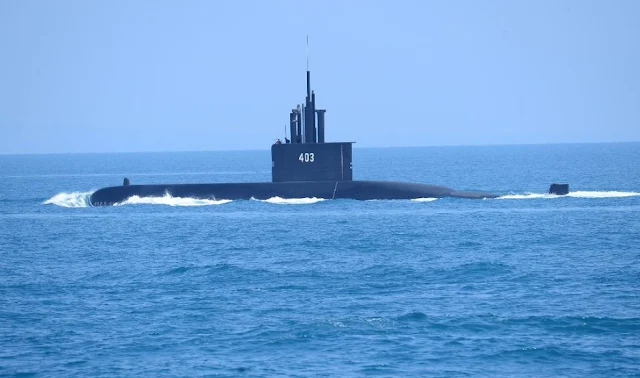 |
| Indonesia's Nagapasa Class Submarine Able To Launch Anti-Ship Missiles |
Jakarta - Indonesia's Nagapasa class submarine is still not known for sure its combat capabilities. This is because the Nagapasa class Indonesia and South Korea themselves with Changbogo have not tested their respective submarines on the battlefield.
Unlike the U-209 which has been tested by the Argentine Navy in the Falkland against England, the Indonesian Nagapasa class does not yet have War Experience. The need for experience on the battlefield helps a defense equipment find its advantages and disadvantages. For example, the Argentine Navy U-209. He was able to escape after cat and mouse with a British warship.
But it was the British submarine HMS Conqueror that captured the most attention in the Falklands war. The HMS Conqueror torpedoed the Argentine Navy's flagship, the ARA General Belgrano, which made the morale of the Buenos Aires troops drop drastically. Since then the world knows that submarines do have a strategic role in combat.
The Soviet Union knew best about the role of submarines. Moscow prefers to increase its submarines over aircraft carriers. A doctrine that contradicts the US Navy. Russia is guided that nuclear submarines accompanied by ICBMs have more lethal destructive power than aircraft carriers. Sneaking in enemy territory and then launching ICBMs from underwater was terrifying for anyone who was attacked.
Russia has many submarines of this type. There used to be an Akula Typhoon class that the West feared. Akula is the largest submarine ever on earth. He became the trump card for Russia during the cold war against the United States.
Indonesia has also experienced how using Soviet-made submarines is very useful on the battlefield. At the time of Trikora, Indonesia obtained 12 units of Whiskey class submarines. These 12 submarines turned out to be a hassle for the Dutch against the Indonesian military. Time and again, the Indonesian Whiskey class infiltrated the west coast of Irian. The Dutch had difficulty anticipating the movement of Indonesian submarines.
After Whiskey, Indonesia used the U-209 class. Then add to its fleet with the Changbogo class which is a derivative of the U-209. Although it is a derivative, in fact South Korea's DSME that made Changbogo did not have a license to manufacture the U-209.
Indonesia bought three improved Changbogo units. Indonesia then called it the Nagapasa class for submarines purchased from South Korea. However, there is news that the Nagapasa class's abilities are not as expected.
Therefore, Indonesia is reluctant to continue the Changbogo Batch II project. Whereas South Korea's DSME has ordered several components to build Indonesia's Changbogo Batch II submarine, and has not confirmed the continuation of the program.
However, pre-orders occur to meet supply deadlines when the company chooses to receive equipment on time. In this case, it is unavoidable that we have to pre-order to meet the signed delivery deadline.
The Indonesian government has not informed or considered the cancellation of the shipbuilding contract, which means that it is not true that DSME did not prepare for the possibility of contract cancellation.
As DSME continues to hold talks with Indonesia to see the contracts take effect and do their best to win new contracts, the media should be careful in reporting based on assumptions," DSME said as quoted by Naval News.
Indonesia does need a really tough submarine spec. At least there are currently two submarine capabilities that are being targeted by Indonesia. First, it must have an Air-independent propulsion (AIP) system. AIP will make the submarine dive longer where the battery can be recharged during diving mode.
Second, Indonesia wants the capability of submarines to launch anti-ship missiles. Because so far
Indonesian submarines have only been able to fire torpedoes against fellow submarines or warships. Indonesia can get these two characteristics in an improved version of the Scorpene like the Riachuelo class of the Brazilian Navy.
Indonesia is indeed interested in making Scoprene, a kind of Riachuelo class, the Brazilian Navy. The Riachuelo can fire the MBDA Exocet SM39 Block II anti-ship missile. Quoted from Janes, Friday, December 4, 2020, officials from the Indonesian defense ministry are in discussions with a consortium led by French shipbuilder Naval Group for a possible order for the Riachuelo (Modified Scorpene) class submarine from the Brazilian Navy.
It seems that this step will soon be realized because Indonesia said it would make two Scorpene units with the French Naval Group. Naval Group is also very happy that they got a submarine contract from Indonesia. "We welcome the statement by the Indonesian Defense Minister to cooperate in the submarine sector between PT PAL and the Naval Group. We have signed a memorandum of understanding for this purpose and look forward to working together on the submarine program to meet the needs of the Indonesian Navy, as well as to strengthen the defense industry. marine dimension in Indonesia through PAL," explained Pierre Eric Pommellet, CEO of Naval Group.
However, the nti.org website in an article published on August 1, 2013 even said that the Indonesian Nagapasa class had the ability to fire anti-ship missiles.
"Indonesia's Nagapasa Class (Type 209/1400) has three Nagapasa Class diesel-electric attack submarines. These submarines are 61 meters long with a beam width of 6.3 meters and can go up to 21.5 knots while submerged. They can stay submerged for about 50 days without surfacing. Their weapon system can fire anti-ship missiles and torpedoes," he explained.
There could be a typo from nti.org in the report. Because according to information on the internet, the Nagapasa class Indonesian submarine is only equipped with 14 Italian-made Black Shark torpedoes, there are no anti-ship missiles there.


